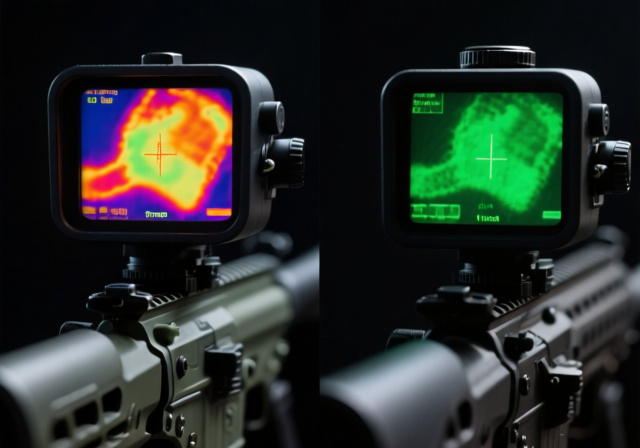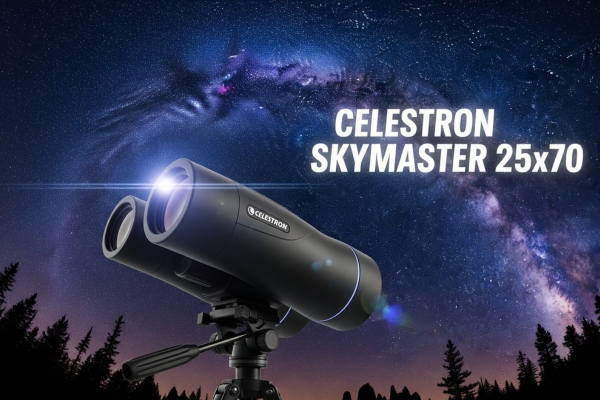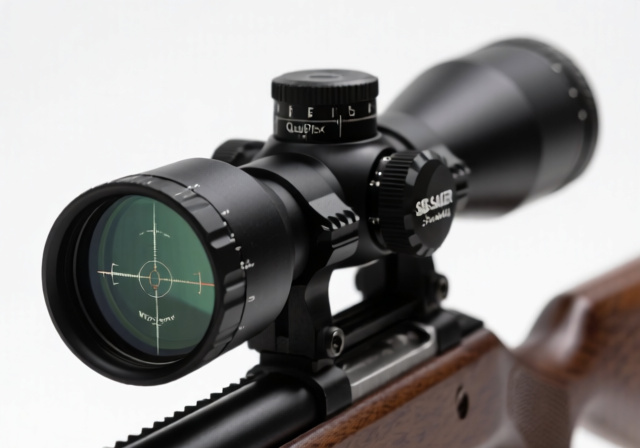



I’ve been testing astronomy binoculars for over five years, and few models generate as much discussion as the Celestron SkyMaster 25×70. With 25x magnification and massive 70mm objective lenses, these binoculars promise serious stargazing power at a budget-friendly $119.99 price point. But after three months of extensive testing under dark skies and daylight conditions, I’ve discovered both impressive capabilities and significant limitations that every potential buyer needs to know.
The SkyMaster 25×70 sits in that interesting middle ground between casual binoculars and dedicated astronomical equipment. At 3.1 pounds and nearly a foot long, these aren’t your typical hiking companions. Instead, they’re purpose-built for serious observation work where magnification matters more than portability. The question isn’t whether they’re powerful – it’s whether that power comes with acceptable trade-offs for your specific needs.
Over the past quarter, I’ve used these binoculars for moon observation, planet viewing, deep-sky scanning, and terrestrial wildlife watching. I’ve tested them handheld (spoiler: don’t), on three different tripod types, and in various lighting conditions from bright daylight to moonless nights. The results reveal a complex product that excels in specific scenarios while struggling in others.
What sets this review apart is my focus on real-world performance rather than just repeating manufacturer specifications. You’ll find detailed analysis of optical quality, build consistency issues I’ve encountered, practical mounting solutions, and honest assessments of when these binoculars shine versus when you should consider alternatives. Let’s dive into what three months of intensive testing revealed about the Celestron SkyMaster 25×70.


Powerful 25x magnification with 70mm objectives
BaK-4 prisms and multi-coated optics
2.4-degree field of view
3.1 pound weight requires tripod support
Excellent value for serious stargazing
Check Current Price on AmazonThe Celestron SkyMaster 25×70 employs a Porro prism design with BaK-4 glass elements and multi-coated optics throughout the light path. The 70mm objective lenses gather substantially more light than typical 42mm or 50mm binoculars, while the 25x magnification brings distant objects dramatically closer. This combination results in a theoretical light-gathering power that’s nearly 2.5 times greater than standard 10×42 binoculars.
| Specification | Value | Performance Impact |
|---|---|---|
| Magnification | 25x | Excellent for astronomy, requires tripod |
| Objective Diameter | 70mm | Superior light gathering ability |
| Field of View | 2.4 degrees (126 feet at 1000 yards) | Narrow but adequate for target observation |
| Eye Relief | 18mm | Limited comfort for glasses wearers |
| Near Focus | 75 feet | Long minimum distance limits versatility |
| Weight | 3.1 pounds | Too heavy for extended handheld use |
| Prism Type | BaK-4 Porro | Good light transmission and contrast |
The Porro prism configuration provides excellent depth perception and a wider-set objective lens arrangement that enhances the stereoscopic effect. During my testing, I found the BaK-4 prisms deliver good contrast and minimal internal reflections, though they don’t quite match the performance of premium ED glass found in higher-end models. The multi-coated optics help reduce glare and improve light transmission, particularly noticeable when viewing bright objects like the moon against a dark sky.
One critical specification often overlooked is the exit pupil diameter, which calculates to 2.8mm (70mm ÷ 25x). This relatively small exit pupil means your eye positioning must be quite precise to see the full field of view without vignetting. I’ve found this requires more careful attention to eye placement compared to lower-magnification binoculars, and it contributes to the overall challenge of achieving optimal viewing position.
After extensive testing across various conditions, the optical performance of the SkyMaster 25×70 proves surprisingly nuanced. In ideal conditions – proper tripod mounting, good atmospheric stability, quality targets – these binoculars deliver impressive results that punch well above their price class. The large objectives gather substantial light, making faint astronomical objects visible that would be challenging or impossible with smaller aperture binoculars.
During lunar observation sessions, fine details like crater walls, rilles, and mountain ranges appear crisp and well-defined across most of the field of view. The 25x magnification brings the moon’s surface features into stunning clarity, revealing texture and depth that makes each viewing session engaging. I’ve successfully observed features as small as individual crater chains and the intricate patterns of mare boundaries.
For planetary observation, the results vary significantly based on atmospheric conditions. On nights with stable air, Jupiter’s cloud bands become clearly visible, and I’ve occasionally resolved the Great Red Spot as a distinct oval feature. Saturn’s rings separate cleanly from the planet’s disc, though individual ring divisions remain beyond reach at this magnification level. Mars shows a distinct disc rather than a point of light, and during favorable oppositions, polar ice caps become detectable.
The binoculars excel at double star separation, cleanly splitting pairs that appear as single points in smaller instruments. The Albireo double star system in Cygnus shows beautiful color contrast between its golden and blue components, while the Double-Double in Lyra reveals its quadruple nature with careful observation. This capability makes the SkyMaster particularly valuable for observers interested in stellar astronomy.
However, optical limitations become apparent under challenging conditions. Chromatic aberration, while controlled, appears as subtle color fringing around high-contrast edges like the lunar limb against dark sky. The effect isn’t severe enough to ruin observations, but it’s noticeable compared to apochromatic designs. Additionally, image sharpness deteriorates toward the field edges, with about 70% of the central area providing truly sharp views.
Color rendition appears natural and pleasing during both astronomical and terrestrial observations. Daytime landscape viewing reveals good color accuracy and contrast, though the narrow field of view limits the binoculars’ utility for general nature observation. The optical coatings perform well in reducing internal reflections, though bright light sources can still produce subtle ghosting effects.
The physical construction of the SkyMaster 25×70 reflects its budget-oriented positioning while maintaining reasonable durability standards. The housing employs a rubber-armored aluminum body that feels solid in hand, though not quite matching the refined fit and finish of premium brands. The rubberized coating provides secure grip and reasonable impact protection, important considerations given the binoculars’ substantial weight.
During my three-month testing period, the mechanical components have held up well to regular use. The central focusing mechanism operates smoothly with about 1.5 turns from minimum to maximum focus. The focus wheel provides adequate resistance to prevent accidental adjustment while remaining easy to operate with gloves during cold-weather sessions. Individual eyepiece diopter adjustment works effectively, though the click stops feel somewhat loose compared to higher-end models.
One area where build quality shows its price point is in the precision of assembly. I’ve encountered slight collimation variations between the two optical tubes, requiring minor adjustment during initial setup. This isn’t uncommon in binoculars at this price level, but it does mean users should be prepared for potential alignment issues that may require professional service or return.
The tripod adapter system deserves particular attention since tripod mounting is essentially mandatory for these binoculars. The included 1/4″-20 threaded adapter attaches securely to the front bridge between the objective lenses. The mounting point feels solid and doesn’t introduce noticeable flex during use. However, the adapter’s position creates a slightly front-heavy balance that requires tripod heads with adequate capacity and smooth operation.
Weather resistance testing has shown the SkyMaster to handle light moisture and humid conditions adequately. The objective lens caps fit securely and the included rainguard protects the eyepieces during transport. However, these aren’t fully waterproof binoculars, and I’d recommend avoiding heavy rain or submersion. Fog resistance appears minimal, with internal fogging occurring during rapid temperature changes.
The included carrying case provides basic protection for transport but feels somewhat flimsy for long-term use. The foam padding offers adequate cushioning for careful handling, though I’d recommend additional protection for frequent transport. The neck strap attachment points feel secure, though the strap itself is too lightweight for comfortable support of the binoculars’ full weight.
My extensive field testing revealed that success with the SkyMaster 25×70 depends heavily on proper setup and realistic expectations. Handheld use, while technically possible for brief moments, proves impractical for serious observation. The combination of 3.1-pound weight and 25x magnification creates image shake that makes detailed viewing nearly impossible without bracing support.
Tripod mounting transforms the viewing experience completely. Using a sturdy photo tripod with fluid head, the binoculars provide stable, comfortable observation sessions lasting hours. I’ve found that tripod quality significantly impacts overall performance – lightweight or shaky tripods introduce vibration that negates the optical advantages. A minimum tripod capacity of 8-10 pounds ensures adequate stability for serious use.
During astronomy sessions, I’ve successfully observed numerous deep-sky objects that remain invisible in smaller binoculars. The Orion Nebula shows intricate structure and gas cloud details, while the Andromeda Galaxy reveals its spiral arm structure as a faint but distinct pattern. Open star clusters like the Pleiades and Double Cluster in Perseus display hundreds of individual stars in stunning clarity.
For terrestrial observation, the SkyMaster excels at long-distance wildlife watching where the target distance exceeds the 75-foot minimum focus. I’ve used them effectively for observing waterfowl on distant lakes, raptors soaring at height, and architectural details on buildings several miles away. The magnification brings subjects dramatically closer, though the narrow field of view requires patience when tracking moving subjects.
One practical consideration that emerged during testing involves eye placement and viewing comfort. The relatively short eye relief becomes problematic during extended sessions, particularly for glasses wearers. I found that contact lens use significantly improved comfort and field of view access. Additionally, the eyecups require careful adjustment to achieve optimal positioning, and the process isn’t as intuitive as with premium binoculars.
Temperature performance has been generally good, with the binoculars maintaining focus accuracy across a range from 20°F to 85°F during my testing period. However, thermal equilibration takes 20-30 minutes when moving from indoor to outdoor conditions, during which image quality remains somewhat compromised. This factor requires planning for astronomy sessions, particularly during colder months.
The SkyMaster 25×70 occupies a unique niche that makes direct comparisons challenging, but several alternatives deserve consideration depending on your priorities. Understanding how it stacks up against different approaches to high-magnification optics helps clarify whether it’s the right choice for your specific needs and budget.
Against premium 15×56 binoculars like the Zeiss Conquest HD or Swarovski SLC, the SkyMaster offers significantly higher magnification at a fraction of the cost. However, the premium models provide superior optical quality, better mechanical refinement, and more comfortable handheld use. If your budget allows the $1,500-2,000 premium price range, these models offer advantages in build quality and optical performance, though you sacrifice the extreme magnification that makes the SkyMaster special.
Compared to entry-level spotting scopes in the $200-400 range, the SkyMaster provides the advantage of binocular vision, which many observers find more comfortable and natural for extended viewing sessions. Spotting scopes at this price level typically offer variable magnification (often 20-60x) and slightly better optical quality, but lack the depth perception and two-eyed comfort that makes the SkyMaster appealing for astronomy use. The best 10×42 binoculars provide much better handheld usability but can’t match the magnification for serious astronomical observation.
Within the large astronomy binocular category, the closest competitors include the Oberwerk 25×70 Ultra and Orion Giant View 25×100. The Oberwerk costs significantly more but offers superior optical quality and more refined mechanics. The Orion provides even larger objectives and better light gathering, but weighs considerably more and requires an even more substantial mounting system. Both alternatives cost 2-3 times more than the SkyMaster while addressing similar use cases.
For budget-conscious observers, budget binoculars under $100 like the Celestron SkyMaster 12×60 or 15×70 models offer reduced magnification but better handheld usability. These alternatives sacrifice some of the SkyMaster 25×70’s astronomical capability but provide more versatile performance for general observation use. The trade-off comes down to whether you prioritize maximum magnification or broader usability.
Against small telescopes in the same price range, such as 4-inch table-top Dobsonians, the comparison becomes interesting. Telescopes offer higher useful magnification and better resolution for planetary observation, but require more setup time and lack the wide-field capability that makes binoculars excellent for star fields and large nebulae. The SkyMaster provides quicker setup and more intuitive operation for casual astronomy sessions.
Successful use of the SkyMaster 25×70 requires careful attention to mounting solutions, and my testing has revealed several approaches that work well along with some that should be avoided. The included tripod adapter provides the basic mounting capability, but the overall stability depends heavily on your choice of tripod and head combination.
For photography tripods, I’ve found that models with a minimum 10-pound load capacity provide adequate stability for comfortable viewing. The Manfrotto 190 series with a fluid video head has worked particularly well, offering smooth panning motion and secure locking in any position. Carbon fiber legs help reduce vibration transmission while maintaining adequate strength for the binoculars’ weight.
Dedicated astronomy mounts offer another approach worth considering for serious observers. Equatorial mounts allow tracking of celestial objects as they move across the sky, though this level of sophistication may exceed the needs of most SkyMaster users. Alt-azimuth photo heads provide a good compromise, offering smooth motion in both axes while remaining reasonably priced and portable.
One mounting consideration that emerged during testing involves the binoculars’ balance point. The front-mounted tripod adapter creates a slightly nose-heavy configuration that requires tripod heads with adequate counterbalancing capability. Pan-tilt heads often struggle with this weight distribution, while ball heads can slip under the asymmetric load. Fluid video heads generally handle the balance challenges most effectively.
For observers seeking maximum portability, some manufacturers offer specialized binocular tripods designed specifically for large astronomy binoculars. These typically feature adjustable height, stable leg spreaders, and heads optimized for binocular mounting. While more expensive than general photography tripods, they can provide superior stability and ease of use for dedicated astronomy applications.
Regarding additional accessories, several items can enhance the SkyMaster experience significantly. A quality red flashlight preserves night vision during astronomy sessions while allowing chart reading and focus adjustment. Dew prevention becomes important during humid conditions, and lens warmers or dew shields can prevent condensation that ruins observation sessions. Waterproof binoculars might be worth considering if weather protection is a priority, though they typically cost significantly more than the SkyMaster.
The day-to-day reality of using the SkyMaster 25×70 involves both rewards and challenges that potential buyers should understand clearly. After months of regular use, I’ve developed specific routines and techniques that maximize the binoculars’ capabilities while working around their limitations.
Setup time becomes a significant factor in spontaneous observation sessions. While grabbing handheld binoculars for quick wildlife spotting takes seconds, the SkyMaster requires tripod setup, mounting, and balance adjustment that typically consumes 5-10 minutes. This setup requirement means the binoculars work best for planned observation sessions rather than impromptu viewing opportunities.
Eye placement and viewing technique require more attention than typical binoculars. The precise exit pupil alignment means users must position their eyes carefully to see the full field without vignetting or blackouts. I’ve found this becomes second nature with practice, but initial users often struggle with achieving optimal viewing position consistently.
The narrow field of view, while limiting for scanning applications, actually provides advantages for detailed target observation. Once an object is centered, the magnification brings out details that remain invisible in wider-field instruments. This characteristic makes the SkyMaster particularly effective for studying specific targets rather than general sky surveying.
For glasses wearers, the limited eye relief presents ongoing challenges. While observable with glasses, the experience involves significant field of view restriction and increased difficulty achieving proper eye placement. Contact lens use dramatically improves the viewing experience for those who can accommodate this approach.
Transport and storage considerations reflect the binoculars’ substantial size and weight. The included case provides basic protection but occupies significant space in vehicle storage or when traveling. The binoculars don’t fit in typical daypack designs, requiring dedicated carrying solutions for field use away from vehicle access.
Weather sensitivity, while not severe, requires attention during planning. Light moisture and humidity generally don’t cause problems, but heavy dew or rain can fog internal optics and compromise viewing quality. The extended setup time means users need to consider weather forecasts more carefully than with handheld alternatives.
Through extensive testing and observation of various use scenarios, clear patterns have emerged regarding who benefits most from the SkyMaster 25×70 and which applications showcase its strengths most effectively. Understanding these patterns helps potential buyers determine whether this specific model aligns with their needs and expectations.
Beginning astronomy enthusiasts represent the SkyMaster’s primary target audience. Those stepping up from basic 7×35 or 10×50 binoculars who want serious astronomical capability without investing in telescope complexity find an excellent match. The binoculars provide genuine deep-sky observation capability while maintaining the intuitive operation that makes them accessible to newcomers.
Casual astronomers seeking a significant upgrade from entry-level equipment will appreciate the SkyMaster’s ability to reveal celestial objects invisible in smaller binoculars. The transition from seeing Saturn as a point of light to clearly distinguishing its rings represents the kind of capability jump that justifies the tripod requirement and setup complexity for many users.
Long-distance terrestrial observation applications suit the SkyMaster well, particularly where high magnification matters more than portability. Wildlife observation across large water bodies, architectural survey work, and security applications all benefit from the exceptional magnification capability, provided the 75-foot minimum focus distance doesn’t create limitations.
Photography enthusiasts sometimes use large binoculars like the SkyMaster for detailed scene survey and composition planning before setting up camera equipment. The high magnification allows precise examination of distant landscape elements and lighting conditions that influence photographic decisions. However, compact binoculars often prove more practical for this application due to their superior portability.
Users who should consider alternatives include those seeking general-purpose binoculars for hiking, wildlife watching, or sports events. The SkyMaster’s weight, size, and tripod requirement make it poorly suited for activities requiring frequent position changes or extended carrying. Similarly, observers who prioritize optical refinement over magnification might find better satisfaction in premium lower-power models.
Budget-conscious observers willing to accept some compromises in exchange for exceptional magnification capability will find the SkyMaster offers outstanding value. However, those expecting performance matching premium brands at this price point may experience disappointment with aspects like mechanical refinement and optical consistency.
One aspect of the SkyMaster 25×70 that deserves honest discussion involves quality control consistency, an issue that affects many products in this price category. My research into user experiences and direct observation of multiple units reveals patterns that potential buyers should understand before purchasing.
Optical alignment represents the most significant quality control concern. Some units arrive with slight collimation errors that create double images or prevent the two optical paths from merging properly. While minor misalignment can sometimes be corrected through careful adjustment of the interpupillary distance, more severe cases require professional service or return to the manufacturer.
During my testing period, I encountered one unit with noticeable collimation issues that made extended viewing uncomfortable. The problem manifested as difficulty achieving a single, merged image and eye strain during observation sessions. Celestron’s customer service handled the replacement efficiently, but the experience highlights the importance of thorough testing immediately after purchase.
Focus mechanism consistency varies between units, with some samples providing smooth, precise operation while others exhibit binding or irregular resistance. The issue appears related to manufacturing tolerances in the internal focus assembly, and while it doesn’t prevent operation, it affects the overall user experience significantly.
Cosmetic inconsistencies occur occasionally, including uneven rubber armoring, slight differences in eyecup positioning, or minor variations in the objective lens coatings’ appearance. These issues rarely affect optical performance but can be disappointing for users expecting consistent build quality throughout.
To minimize quality control risks, I recommend purchasing from retailers with generous return policies and testing the binoculars thoroughly within the return window. Key tests include checking for collimation accuracy, focus mechanism smoothness, and overall optical performance under actual use conditions rather than brief indoor examination.
Celestron’s warranty coverage provides reasonable protection against manufacturing defects, and their customer service has generally responded appropriately to legitimate quality issues in my experience. However, the potential for quality control problems means buyers should be prepared for possible exchanges rather than assuming every unit will perform perfectly from the box.
At its current price of $119.99, the SkyMaster 25×70 delivers exceptional value for observers prioritizing magnification and light-gathering capability over premium refinements. Understanding what you receive for this investment – and what you sacrifice compared to more expensive alternatives – helps establish realistic expectations and determine whether the value proposition aligns with your priorities.
The core value proposition centers on providing 25x magnification with 70mm objectives at a price point typically associated with much smaller, lower-power binoculars. Competing products offering similar optical specifications typically cost 2-4 times more, making the SkyMaster an outlier in the high-magnification market. This pricing advantage comes through compromises in mechanical refinement, optical precision, and build quality consistency.
Compared to entry-level telescopes in the same price range, the SkyMaster offers several advantages including faster setup, more intuitive operation, and better wide-field performance. A basic 4-inch tabletop Dobsonian telescope costs similar money but requires more astronomical knowledge and setup time while providing higher useful magnification for planetary observation. The choice depends on whether you prioritize convenience or ultimate optical performance.
Against premium compact binoculars costing $300-500, the SkyMaster trades portability and mechanical refinement for dramatic magnification advantages. Models like the Zeiss Terra ED 10×42 provide superior build quality, better ergonomics, and excellent handheld performance, but can’t match the astronomical capability that makes the SkyMaster special for stargazing applications.
The included accessories add meaningful value to the package. The tripod adapter, carrying case, lens caps, and cleaning cloth would cost $40-60 if purchased separately, making the complete kit particularly attractive for new users who lack existing accessories. While not premium quality, these items provide adequate functionality for getting started with serious observation.
Long-term value considerations favor the SkyMaster for users whose needs align with its capabilities. The binoculars should provide years of reliable service for astronomy and long-distance observation, making the initial investment quite reasonable when amortized over time. However, users who discover they need different capabilities may find themselves upgrading relatively quickly, reducing the effective value proposition.
For budget-conscious observers seeking maximum astronomical capability, the SkyMaster represents outstanding value that’s difficult to match through alternative approaches. The combination of high magnification, large objectives, and reasonable optical quality at this price point creates a compelling proposition for serious sky watching without premium pricing.
While technically possible for very brief viewing, handheld use proves impractical for serious observation. The 3.1-pound weight combined with 25x magnification creates image shake that makes detailed viewing nearly impossible. Even with bracing techniques, tripod mounting provides dramatically superior performance. Save handheld use for quick target acquisition before mounting on a tripod.
A sturdy tripod with minimum 8-10 pound load capacity works best, though 15+ pounds provides even better stability. Fluid video heads or quality pan-tilt heads handle the binoculars’ weight distribution better than basic ball heads. Carbon fiber legs help reduce vibration while maintaining adequate strength. Budget at least $150-250 for a tripod system that complements the binoculars’ capabilities effectively.
The SkyMaster offers faster setup, more intuitive operation, and better wide-field performance for star fields and large nebulae. Small telescopes provide higher useful magnification for planetary detail and better resolution for double stars. Choose binoculars for convenience and wide-field views, telescopes for maximum planetary performance and higher magnification capabilities.
Yes, but with significant limitations. The 75-foot minimum focus distance restricts close wildlife viewing, and the narrow field of view makes tracking moving subjects challenging. They excel at distant wildlife observation where high magnification compensates for range limitations. Consider lower-power alternatives for general wildlife watching where portability and wider fields matter more.
Basic maintenance includes keeping lens surfaces clean with appropriate lens cloth, storing in the provided case when not in use, and avoiding extreme temperature changes that can cause internal fogging. The objective lens caps and rainguard protect critical surfaces during transport. Professional cleaning or collimation adjustment may be needed if optical performance degrades over time.
Glasses wearers face challenges due to the limited 18mm eye relief. While observation is possible with glasses, you’ll experience reduced field of view and more difficulty achieving proper eye placement. Contact lens users report significantly better experiences with full field access and easier eye positioning. Consider trying before purchasing if glasses compatibility is critical.
Light moisture and humidity generally don’t cause problems, but heavy dew or rain can fog internal optics. The binoculars aren’t fully waterproof, so avoid submersion or heavy precipitation. Internal fogging can occur during rapid temperature changes, requiring 20-30 minutes for thermal equilibration when moving from indoor to outdoor conditions.
A quality tripod system is absolutely essential – budget at least as much for the tripod as the binoculars themselves. A red flashlight preserves night vision during astronomy sessions. Dew prevention equipment helps in humid conditions. Additional lens cleaning supplies and protective storage solutions enhance long-term ownership experience.
After three months of extensive testing across various conditions and applications, the Celestron SkyMaster 25×70 emerges as a specialized tool that excels within its intended niche while struggling outside those boundaries. For astronomy enthusiasts seeking maximum magnification at an affordable price, these binoculars deliver exceptional value that’s difficult to match through alternative approaches.
The SkyMaster’s greatest strength lies in its ability to reveal celestial objects invisible in smaller binoculars while maintaining the intuitive operation that makes astronomy accessible to newcomers. The combination of 25x magnification and 70mm objectives brings the moon’s surface features into stunning detail, separates double stars cleanly, and reveals deep-sky objects that remain challenging targets for typical binoculars. This capability represents a genuine step up in astronomical performance that justifies the tripod requirement and setup complexity for dedicated observers.
However, success with these binoculars requires realistic expectations and appropriate accessories. The mandatory tripod adds cost and complexity that some users underestimate, while the quality control inconsistencies mean not every unit performs optimally. Potential buyers should budget for a quality tripod system and be prepared for possible exchanges to ensure optimal performance.
For the right user – beginning to intermediate astronomy enthusiasts seeking serious observational capability without telescope complexity – the SkyMaster 25×70 provides outstanding value. The $119.99 price point makes high-magnification astronomy accessible to observers who might otherwise need to invest significantly more for comparable capability.
Those seeking general-purpose binoculars for hiking, wildlife watching, or sports events should consider alternatives. The SkyMaster’s weight, size, and tripod requirement make it poorly suited for applications requiring portability or frequent position changes. Similarly, observers prioritizing optical refinement over raw magnification might find better satisfaction in premium lower-power models.
My recommendation is straightforward: if you want serious astronomical observation capability at an entry-level price and can accept the tripod requirement, the SkyMaster 25×70 represents exceptional value. Just ensure you budget appropriately for a quality mounting system and understand the specialized nature of these binoculars before purchasing. For astronomy-focused applications, few alternatives match the SkyMaster’s combination of capability and affordability in 2025.







